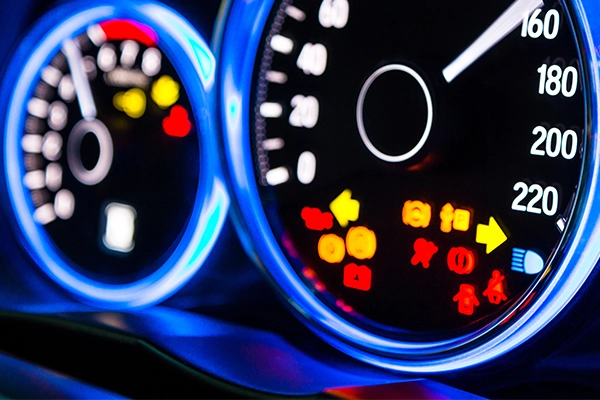Modern vehicles use an array of dashboard lights to communicate essential information to the driver, ranging from the status of the passenger seatbelt to warnings of an overheating engine. With so many different systems in your vehicle, it can be daunting noticing an unfamiliar icon illuminate on your dashboard.
Fortunately, the icon itself can tell you a lot about the location and type of issue your vehicle is experiencing. In this article, we’ll go over how to read the varying warning lights on your dash, the common reasons for them, and what it could mean for the condition of your vehicle.

Color Of The Light
One of the easiest ways to get some information on the source of your warning light is to check the color of the icon itself, as these indicators are generally color-coded based on their severity and immediate importance.
It’s important to note that the colors used for each specific system can vary by manufacturer, and it’s always crucial to narrow down what system is causing the warning prior to further driving.
Blue/Green
A blue or green light on the dashboard is typically strictly for indicating that a specific system of the vehicle is active and working as intended, such as the high beams, lane-assist, or turn signals. These lights are generally require the least attention, as they’re relaying information about an active system rather than a malfunction.
Yellow/Orange
A yellow or orange light is typically more pressing, and likely means that a system in your vehicle is experiencing an issue that needs attention soon. Generally, problems that trigger these lights do not prevent you from driving the vehicle, but should never be ignored as the issues can range in severity. Common examples of warning lights like this include the infamous check-engine light, tire-pressure management system light, and seatbelt-off warning light.
Red
Red lights are generally warnings that require immediate attention, and should be addressed as soon as possible. Common examples of a red warning light on the dash include the oil pressure light, coolant temperature warning light, and the brake warning light.
There is sometimes overlap between the yellow and red icons depending on the manufacturer, and both colors of light should be taken seriously to avoid ignoring a pressing issue in your vehicle.
Most Common Warning Lights
While the color of the light can provide you with a little information on the severity of the issue, it’s still important to be aware of the meanings of the most commonly-seen warning lights, including:
Check-Engine Light
The check-engine light (CEL) is the icon used to indicate problems within the vehicle’s engine or powertrain, and typically resemble the rough outline of an engine. These are always accompanied by a more specific diagnostic code that can give you a ballpark estimate of the issue’s location. These codes are generally found through the vehicle’s OBD2 input using a diagnostic code reader.
Because the motor is such a complex system with so many moving parts, further diagnostics are often needed to narrow down the true source of the issue, however the initial CEL icon can warn you of potentially critical issues before they transpire into expensive drivetrain damage.
Brake Warning Light
The brake warning lights, which is typically a red or orange circle with an exclamation mark in the center. This light is illuminated to warn the driver of issues within the brake system, such as low brake fluid volume or low brake pad thickness.
Oil Light
The oil warning light, which generally appears as an oil lamp (the kind you’d expect a genie to pop out of). This icon is typically an indicator of either low oil volume, or more critically, low oil pressure. An engine without proper lubrication is bound to experience expensive failure, so oil warning lights should be addressed as soon as possible to prevent drivetrain damage.
TPMS Light
The tire pressure management system (TPMS) light is used to warn the driver of inadequate or excess pressure in the tires. This light most often appears when a tire is experiencing a leak, however it may also appear if the tires have been overfilled. The TPMS light icon will often appear as a cross section of a tire with an exclamation point in the center.
The TPMS light may also be triggered by outside temperature changes, as surrounding heat can have a significant effect on the PSI within the tires.
Traction Control Light
The traction control light indicates the status of your vehicle’s traction control system, which adjusts the power delivery to each tire and keeps your vehicle under control in low-grip situations. This light generally appears as an icon of a vehicle with skid marks behind it.
The traction control light will often pop-up momentarily when the system is correcting to alert you the system is active. However, if the light stays illuminated solid, it likely means there’s an issue within the traction control system itself.
Battery Warning Light
The battery warning light might seem self explanatory, especially as the icon itself generally looks like a car battery. However, this light indicates problems in the electrical system as a whole, including the charging system that keeps your vehicle’s battery juiced up.
While it can be triggered by a weak battery or faulty connection, it also may be indicating problems with the alternator, a bad accessory belt, or other internal electrical problems.
Automotive Diagnostics in Spicewood, Texas
If you notice one of the above-mentioned lights, or any other dashboard warning, don’t hesitate to schedule with the experienced team at Vineyard Bay Automotive in Spicewood, Texas. Our technicians will use state-of-the-art equipment and training to narrow down the exact source of your vehicle’s issue, and return it to running as it should in no time!
Give us a call or schedule online today to secure your appointment with Spicewood’s premier diagnostic, service, and repair facility.




